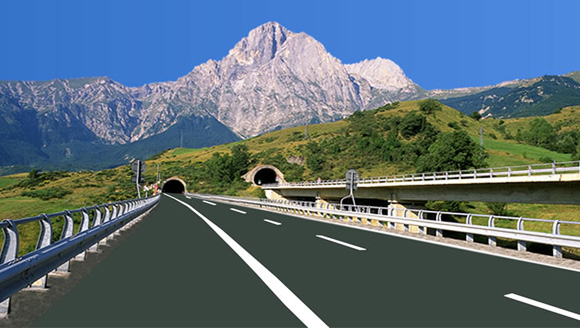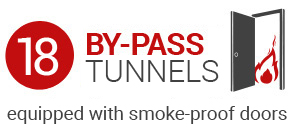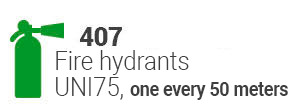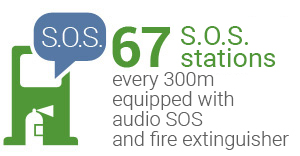Surmounted by the 2912-meter Corno Grande, the Gran Sasso Tunnel crosses the mountain at an average elevation of 973 m a.s.l. With a development of more than 10,000 meters, it is one of the few European tunnels of this length having two lanes in each direction.

How the Gran Sasso Tunnel was born
Built to eliminate the difficulties associated with crossing the Gran Sasso mountain massif, the Tunnel consists of two parallel tunnels connected by short transverse tunnels (bypasses) equipped with smoke gates, arranged between them at distances varying from 400 to 800 meters. There is also a third service tunnel on the Teramo side of 2628 m.
Interspersed at a distance of about 300 meters, along the right wall are niches equipped with fire extinguishers and a phonic-type SOS column with rescue call selection; a longitudinal ventilation system, consisting of coupled axial electric fans installed on the vault of both tunnels, allows the dispersion of fumes, which are kept under control by a network of sensors; 102 cameras ensure continuous monitoring of the entire route; and two variable message portals, positioned before the respective entrances, are able to provide any emergency information.
On the west fornix of the Tunnel is located the access to the underground laboratories of the National Institute of Nuclear Physics, among the largest and most important underground laboratories in the world.
The heart of the Tunnel: the Operations Center
The Tunnel is controlled by an Operations Center (Plant Monitoring Center), manned 24 hours a day by specialized technicians, and since 2003, an emergency service has been in operation, with a fixed 24-hour garrison , capable of guaranteeing first aid in any emergency situation and particularly in case of fire.
The prevailing function of the service is to intervene quickly in case of vehicle fires in transit in or adjacent to the tunnels, and in all cases of critical and potentially dangerous situations such as stalled vehicles, obstacles in the roadway, etc., by carrying out traffic interventions in support of the Traffic Police and Traffic Auxiliaries of the Strada dei Parchi Concessionaire.
Operators are also able to provide medical first aid by having an intervention kit with collars and a defibrillator.
Rules of conduct inside the tunnel
a) In case of fire to one’s own car:
– If the fire is still in the early stages, attempt to extinguish it by making use of the on-board fire extinguisher or one located in the S.O.S. niches;
– If the fire has already developed or cannot be extinguished, follow procedure b);
b) In case of fire:
– Abandon the car, turning off the engine, possibly pulling it over to the right;
– Reach the nearest emergency exit by following the emergency signs proceeding in the opposite direction of the smoke;
– Go through the emergency door and wait for help to arrive without encroaching on the roadway of the opposite tunnel, which is traveled by traffic;
c) In case of an accident to your car:
– If you are able to get out of the car, turn off the engine and wait for help to arrive away from traffic;
d) In case of blocked traffic or red lights:
– Stop the car by pulling over to the right while maintaining appropriate safety distances and turn off the engine;
e) If yellow flashing lights are on:
– Proceed with great caution.
In any case, call for help from the appropriate S.O.S. columns, see how.
Rules of conduct outside the tunnel
There are signal portals near tunnel entrances that indicate the presence or absence of blocked traffic in the tunnel; three cases can occur:
(a) Green lights: there are no special dangerous conditions in the tunnel, so you can proceed, always with caution;
(b) Yellow traffic lights: there are potentially dangerous conditions in the tunnel, although not such as to require it to be closed, so it may be proceeded with, however, using all appropriate precautions;
(c) Red lights: one must necessarily stop by queuing up with cars already stopped and leaving the emergency lane clear. You may restart only when the traffic lights have turned green again.
Always strictly observe the standards indicated.









